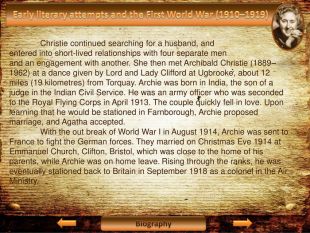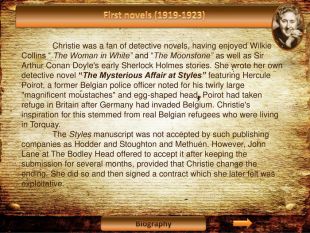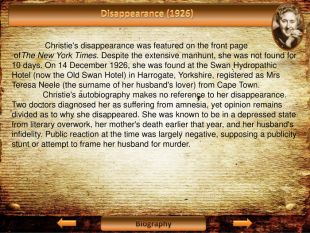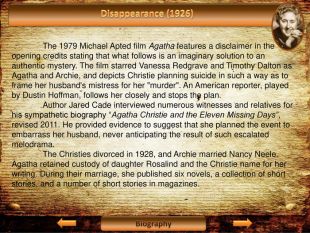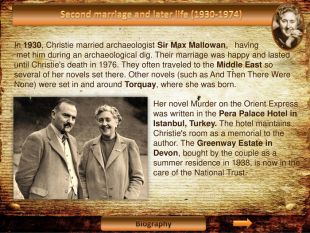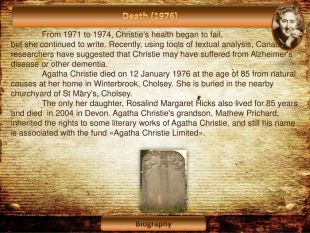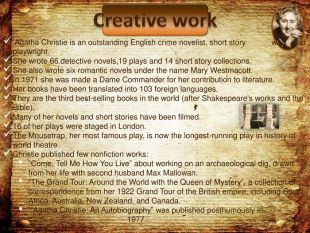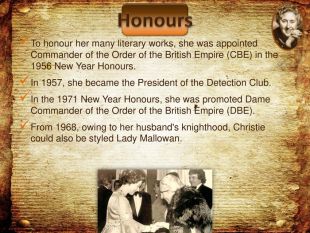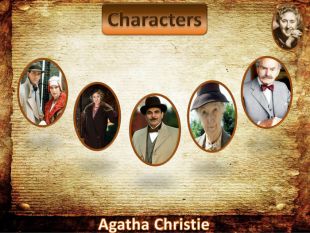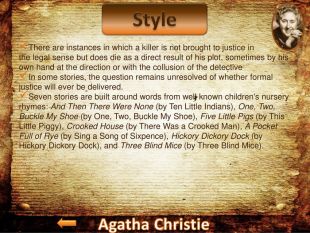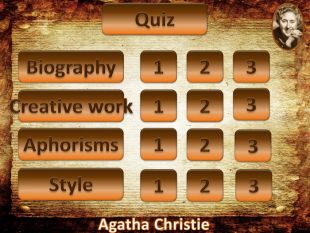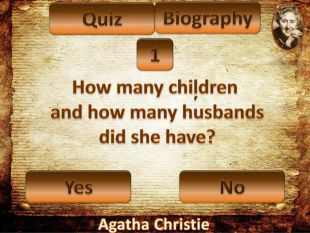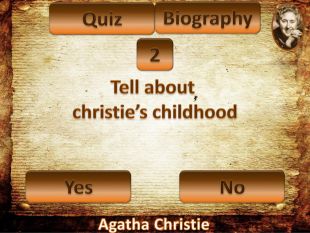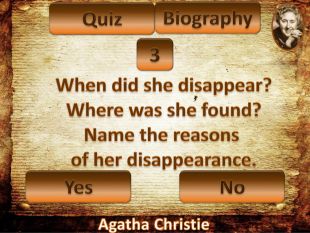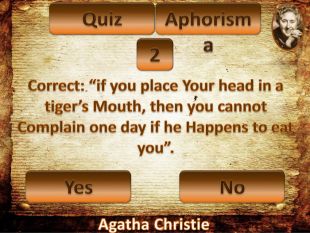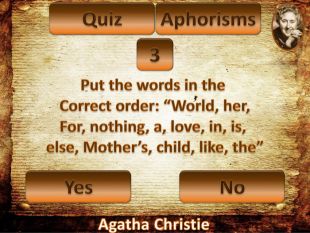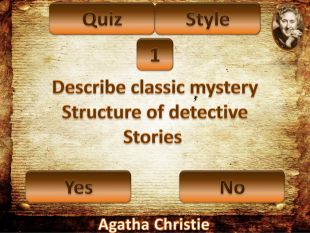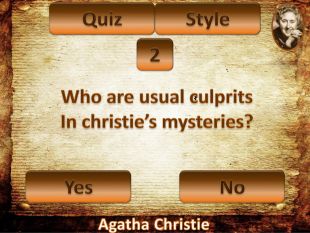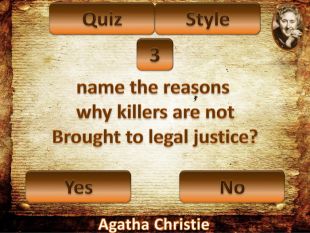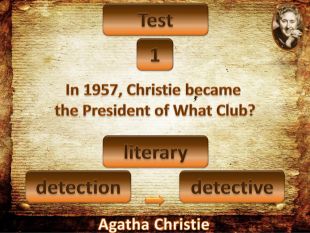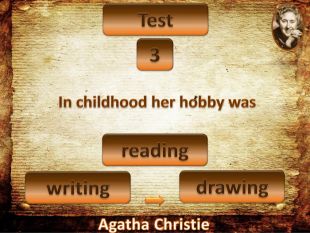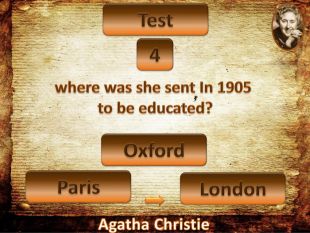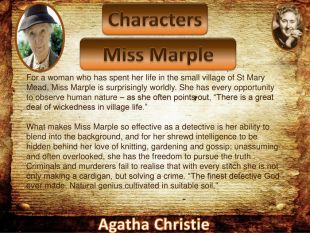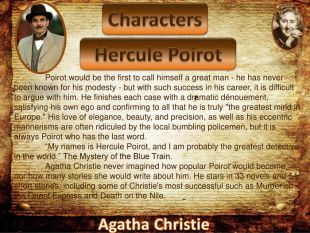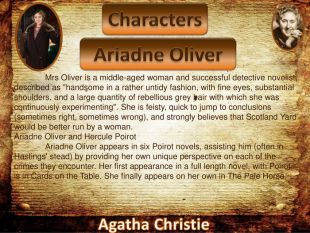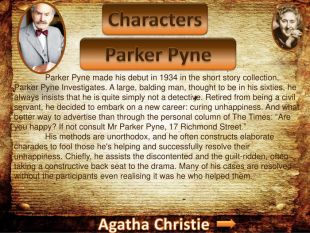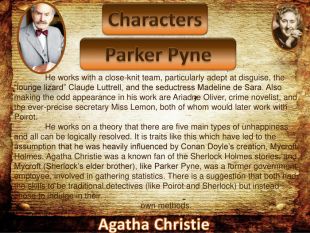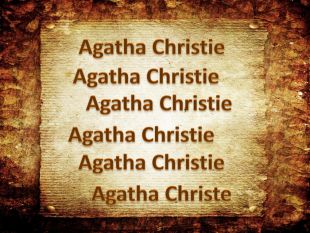Інтерактивна презентація "Agatha Christie"

























































Biography. Early years (1890-1910) Agatha Mary Clarissa Miller was born on 15 September 1890 in a wealthy family in Ashfield, Torquay, Devon. Her mother,Clara Boehmer, was an Englishwoman . Her father, an American stockbroker named Frederick Alvah Miller, was the son of Nathaniel. He was a member of the small and wealthy American upper class. They had three children - Margaret Frary Miller (1879–1950), Louis "Monty" Montant (1880–1929) and Agatha. Christie described her childhood as "very happy". She was surrounded by a series of strong and independent women from an early age. Her time was spent alternating between her home in Devon, her step-grandmother and aunt's house in Ealing, West London, and parts of Southern Europe, where her family had holiday during the winter. Her mother insisted that she receive a home education, and so her parents were responsible for teaching her to read and write and to be able to know basic arithmetic, a subject that she enjoyed. They also taught her about music, and she learned to play both the piano and the mandolin.
Early years (1890-1910) Christie was fond of reading from an early age. Much of her childhood was spent largely alone and separate from other children, although she spent much time with her pets, whom she adored. Her father was often ill, suffering from heart attacks, and he died in November 1901, aged 55. His death left the family devastated and in an uncertain economic situation. Clara and Agatha continued to live together in their Torquay home, Madge moved to the nearby Cheadle Hall with her new husband, and Monty joined the army and was sent to South Africa to fight in the War. Later Agatha said that her father's death, occurring when she was eleven years old, marked the end of her childhood. In 1902, Agatha was sent to receive a formal. Education at Miss Guyer's Girls School in Torquay, but found it difficult to adjust to the disciplined atmosphere. In 1905, she was sent to Paris where she was educated in three pensions . Biography
Early literary attempts and the First World War (1910–1919) Agatha returned to England in 1910 and found that her mother Clara was ill. They decided to spend time together in the warmer climate of Cairo, in a popular Hotel. Agatha – always chaperoned by her mother – attended many social functions in search of a husband. She visited such ancient Egyptian monuments as the Great Pyramid, but did not exhibit the great interest in archaeology and Egyptology that became prominent in her later years. Returning to Britain, she continued her social activities, writing and performing in amateur theatrics. She also helped put on a play called The Blue Beard of Unhappiness with female friends. Her writing extended to both poetry and music. Some early works saw publication, but she decided against focusing on either of these as future professions. Christie wrote her first short story, The House of Beauty (an early version of her later-published story The House of Dreams), while recovering in bed from an undisclosed illness. Biography
Early literary attempts and the First World War (1910–1919) Other shorts followed, most of them illustrating her interest in spiritualism and the paranormal. These included "The Call of Wings" and "The Little Lonely God". Various magazines rejected all her early submissions, made under pseudonyms, although some were revised and published later, often with new titles. Christie then set her first novel, Snow Upon the Desert, in Cairo, and drew from her recent experiences in that city, written under the pseudonym Monosyllaba. She was perturbed when various publishers all declined. Clara suggested that her daughter ask for advice from a family friend and neighbour, writer Eden Philpotts, who obliged her enquiry, encouraged her writing, and sent her an introduction to his own literary agent, Hughes Massie, who rejected Snow Upon the Desert, and suggested a second novel.. Biography
Early literary attempts and the First World War (1910–1919) Christie continued searching for a husband, andentered into short-lived relationships with four separate men and an engagement with another. She then met Archibald Christie (1889–1962) at a dance given by Lord and Lady Clifford at Ugbrooke, about 12 miles (19 kilometres) from Torquay. Archie was born in India, the son of a judge in the Indian Civil Service. He was an army officer who was seconded to the Royal Flying Corps in April 1913. The couple quickly fell in love. Upon learning that he would be stationed in Farnborough, Archie proposed marriage, and Agatha accepted. With the out break of World War I in August 1914, Archie was sent to France to fight the German forces. They married on Christmas Eve 1914 at Emmanuel Church, Clifton, Bristol, which was close to the home of his parents, while Archie was on home leave. Rising through the ranks, he was eventually stationed back to Britain in September 1918 as a colonel in the Air Ministry. Biography
Early literary attempts and the First World War (1910–1919) Agatha involved herself in the war effort, joining the Voluntary Aid Detachment (VAD) in 1914, and attending to wounded soldiers at a hospital in Torquay as an unpaid VAD nurse. She was responsible for aiding the doctors and maintaining morale; she performed 3,400 hours of unpaid work between October 1914 and December 1916. She qualified as an "apothecaries' assistant" (or dispenser) in 1917 and, as a dispenser, she earned £16 a year until the end of her service in September 1918. After the war, the couple settled into a flat at 5 Northwick Terrace in St. John's Wood, northwest London. Biography
First novels (1919-1923) Christie was a fan of detective novels, having enjoyed Wilkie Collins “ The Woman in White” and “The Moonstone” as well as Sir Arthur Conan Doyle's early Sherlock Holmes stories. She wrote her own detective novel “The Mysterious Affair at Styles” featuring Hercule Poirot, a former Belgian police officer noted for his twirly large "magnificent moustaches" and egg-shaped head. Poirot had taken refuge in Britain after Germany had invaded Belgium. Christie's inspiration for this stemmed from real Belgian refugees who were living in Torquay. The Styles manuscript was not accepted by such publishing companies as Hodder and Stoughton and Methuen. However, John Lane at The Bodley Head offered to accept it after keeping the submission for several months, provided that Christie change the ending. She did so and then signed a contract which she later felt was exploitative. Biography
First novels (1919-1923) Christie meanwhile settled into married life, giving birth to her only child, daughter Rosalind Margaret at Ashfield in August 1919, where the couple spent much of their time, having few friends in London. Archie left the Air Force at the end of the war and started working in the City financial sector at a relatively low salary, though they still employed a maid. Christie's second novel, “The Secret Adversary” (1922), featured a new detective couple Tommy and Tuppence, again published by The Bodley Head. It earned her £50. A third novel again featured Poirot, “Murder on the Links” (1923), as did short stories commissioned by Bruce Ingram, editor of Sketch magazine. In order to tour the world promoting the British Empire Exhibition, the couple left their daughter Rosalind with Agatha's mother and sister. They travelled to South Africa, Australia, New Zealand, and Hawaii. They learned to surf prone in South Africa; then, in Waikiki, they were among the first Britons to surf standing up. Biography
Disappearance (1926) In late 1926, Archie asked Agatha for a divorce. He was in love with Nancy Neele. On 3 December 1926, the Christies quarrelled, and Archie left their house, Styles, in Sunningdale, Berkshire, to spend the weekend with his mistress at Godalming, Surrey. That same evening, around 9:45 pm, Christie disappeared from her home, leaving behind a letter for her secretary saying that she was going to Yorkshire. Her car was later found at Newlands Corner, perched above a chalk quarry, with an expired driving licence and clothes. Her disappearance caused an outcry from the public. Home Secretary William Joynson-Hicks pressured police, and a newspaper offered a £100 reward. Over a thousand police officers, 15,000 volunteers, and several aeroplanes scoured the rural landscape. Sir Arthur Conan Doyle even gave a spirit medium one of Christie's gloves to find the missing woman. Biography
Disappearance (1926) Christie's disappearance was featured on the front page of. The New York Times. Despite the extensive manhunt, she was not found for 10 days. On 14 December 1926, she was found at the Swan Hydropathic Hotel (now the Old Swan Hotel) in Harrogate, Yorkshire, registered as Mrs Teresa Neele (the surname of her husband's lover) from Cape Town. Christie's autobiography makes no reference to her disappearance. Two doctors diagnosed her as suffering from amnesia, yet opinion remains divided as to why she disappeared. She was known to be in a depressed state from literary overwork, her mother's death earlier that year, and her husband's infidelity. Public reaction at the time was largely negative, supposing a publicity stunt or attempt to frame her husband for murder. Biography
Disappearance (1926) The 1979 Michael Apted film Agatha features a disclaimer in the opening credits stating that what follows is an imaginary solution to an authentic mystery. The film starred Vanessa Redgrave and Timothy Dalton as Agatha and Archie, and depicts Christie planning suicide in such a way as to frame her husband's mistress for her "murder". An American reporter, played by Dustin Hoffman, follows her closely and stops the plan. Author Jared Cade interviewed numerous witnesses and relatives for his sympathetic biography “Agatha Christie and the Eleven Missing Days”, revised 2011. He provided evidence to suggest that she planned the event to embarrass her husband, never anticipating the result of such escalated melodrama. The Christies divorced in 1928, and Archie married Nancy Neele. Agatha retained custody of daughter Rosalind and the Christie name for her writing. During their marriage, she published six novels, a collection of short stories, and a number of short stories in magazines. Biography
Disappearance (1926) The 1979 Michael Apted film Agatha features a disclaimer in the opening credits stating that what follows is an imaginary solution to an authentic mystery. The film starred Vanessa Redgrave and Timothy Dalton as Agatha and Archie, and depicts Christie planning suicide in such a way as to frame her husband's mistress for her "murder". An American reporter, played by Dustin Hoffman, follows her closely and stops the plan. Author Jared Cade interviewed numerous witnesses and relatives for his sympathetic biography “Agatha Christie and the Eleven Missing Days”, revised 2011. He provided evidence to suggest that she planned the event to embarrass her husband, never anticipating the result of such escalated melodrama. The Christies divorced in 1928, and Archie married Nancy Neele. Agatha retained custody of daughter Rosalind and the Christie name for her writing. During their marriage, she published six novels, a collection of short stories, and a number of short stories in magazines. Biography
Second marriage and later life (1930-1974)In 1930, Christie married archaeologist Sir Max Mallowan, having met him during an archaeological dig. Their marriage was happy and lasted until Christie's death in 1976. They often traveled to the Middle East so several of her novels set there. Other novels (such as And Then There Were None) were set in and around Torquay, where she was born. Her novel Murder on the Orient Express was written in the Pera Palace Hotel in Istanbul, Turkey. The hotel maintains Christie's room as a memorial to the author. The Greenway Estate in Devon, bought by the couple as a summer residence in 1938, is now in the care of the National Trust. Biography
Second marriage and later life (1930-1974)Christie often stayed at Abney Hall, Cheshire, owned by her brother-in-law, James Watts, basing at least two stories there: a short story "The Adventure of the Christmas Pudding", in the story collection of the same name, and the novel After the Funeral. Abney became Agatha's greatest inspiration for country-house life, with all its servants and grandeur being woven into her plots. The descriptions of the fictional Chimneys, Stoneygates, and other houses in her stories are mostly Abney in various forms. Biography
Second marriage and later life (1930-1974)During the Second World War, Christie worked in the pharmacy at University College Hospital, London, where she got some knowledge of poisons that she used in her post-war crime novels. For example, the use of thallium as a poison was suggested to her by UCH Chief Pharmacist Harold Davis (later appointed Chief Pharmacist at the UK Ministry of Health), and in The Pale Horse, published in 1961, she employed it to dispatch a series of victims, the first clue to the murder method coming from the victims' loss of hair. So accurate was her description of thallium poisoning that on at least one occasion it helped solve a casethat was baffling doctors. Biography
Second marriage and later life (1930-1974)She and Max Mallowan bought a house in Wallingford, (Oxfordshire, UK). This was their main residence for the rest of their lives and the place where Christie did most of her writing. Christie led a very low-profile life despite being known in the town of Wallingford, where she was for many years President of the localamateur dramatic society. Biography
Second marriage and later life (1930-1974)Around 1941–1942, the British intelligence agency MI5 investigated Christie after a character called Major Bletchley appeared in her 1941 thriller “N or M?”, which was about a hunt for a pair of deadly fifth columnists in wartime England. MI5 was afraid that Christie had a spy in Britain's top-secret codebreaking centre, Bletchley Park. The agency's fears were allayed when Christie commented to codebreaker Dilly Knox that Bletchley was simply the name of "one of my least lovable characters.“ Biography
Death (1976) From 1971 to 1974, Christie's health began to fail, but she continued to write. Recently, using tools of textual analysis, Canadian researchers have suggested that Christie may have suffered from Alzheimer's disease or other dementia. Agatha Christie died on 12 January 1976 at the age of 85 from natural causes at her home in Winterbrook, Cholsey. She is buried in the nearby churchyard of St Mary's, Cholsey. The only her daughter, Rosalind Margaret Hicks also lived for 85 years and died in 2004 in Devon. Agatha Christie's grandson, Mathew Prichard, inherited the rights to some literary works of Agatha Christie, and still his name is associated with the fund «Agatha Christie Limited». Biography
Agatha Christie is an outstanding English crime novelist, short story writer and playwright. She wrote 66 detective novels,19 plays and 14 short story collections. She also wrote six romantic novels under the name Mary Westmacott. In 1971 she was made a Dame Commander for her contribution to literature. Her books have been translated into 103 foreign languages. They are the third best-selling books in the world (after Shakespeare's works and the Bible). Many of her novels and short stories have been filmed. 16 of her plays were staged in London. The Mousetrap, her most famous play, is now the longest-running play in history of world theatre. Christie published few nonfiction works:“Come, Tell Me How You Live” about working on an archaeological dig, drawn from her life with second husband Max Mallowan.“The Grand Tour: Around the World with the Queen of Mystery”, a collection of correspondence from her 1922 Grand Tour of the British empire, including South Africa, Australia, New Zealand, and Canada. “Agatha Christie: An Autobiography” was published posthumously in 1977. Creative work
Honours. To honour her many literary works, she was appointed Commander of the Order of the British Empire (CBE) in the 1956 New Year Honours. In 1957, she became the President of the Detection Club. In the 1971 New Year Honours, she was promoted Dame Commander of the Order of the British Empire (DBE). From 1968, owing to her husband's knighthood, Christie could also be styled Lady Mallowan.
Agatha Christie. Style. Christie built her plots in classic mystery structure: a murder is committed, there are multiple suspects who are all concealing secrets, and the detective gradually uncovers these secrets over the course of the story, discovering the most shocking twists towards the end. Culprits in Christie's mysteries included children, policemen, narrators, already deceased individuals, and sometimes comprise no known suspects or all of the suspects. At the end, the detective usually gathers the surviving suspects into one room, explains the course of his deductive reasoning, and reveals the guilty party, although there are exceptions in which it is left to the guilty party to explain all. Christie allows some culprits to escape earthly justice for a variety of reasons, such as the passage of time (retrospective cases), in which the most important characters have already died, or by active prescription.
Agatha Christie. Style. There are instances in which a killer is not brought to justice in the legal sense but does die as a direct result of his plot, sometimes by his own hand at the direction or with the collusion of the detective. In some stories, the question remains unresolved of whether formal justice will ever be delivered. Seven stories are built around words from well known children's nursery rhymes: And Then There Were None (by Ten Little Indians), One, Two, Buckle My Shoe (by One, Two, Buckle My Shoe), Five Little Pigs (by This Little Piggy), Crooked House (by There Was a Crooked Man), A Pocket Full of Rye (by Sing a Song of Sixpence), Hickory Dickory Dock (by Hickory Dickory Dock), and Three Blind Mice (by Three Blind Mice).
Agatha Christie. Aphorisms. When you find that people are not telling you the truth – look out!Anyone who has never really loved has never really lived. Never do anything yourself that others can do for you. One of the luckiest things that can happen to you in life is, I think, to have a happy childhood. Very few of us are what we seem. One doesn`t recognize the really important moments in one`s life until it`s too late. Where large sums of money are concerned, it is advisable to trust nobody. Every murderer is probably somebody`s old friend. But surely for everything you love you have to pay some price.
Agatha Christie. Aphorisms. Any woman can fool a man if she wants to and if he`s in love with her. Believe me, nurse, the difficulty of beginning will be nothing to the difficulty of knowing how to stop. At least that's the way it is with me when i have to make a speech. Someone's got to catch hold of my coat-tails and pull me down by main force. Exactly! It is absurd, improbable, it cannot be. So I myself have said. And yet, my friend, there it is! One cannot escape from the facts. I do not argue with obstinate men. I act in spite of them. Curios things, habits. People themselves never knew they had them.
Agatha Christie. Aphorisms. A mother’s love for her child is like nothing else in the world. An appreciative listener is always stimulating. An archaeologist is the best husband a woman can have. The older she gets the more interested he is in her. At my time of life, one knows that the worst is usually true. I know there’s a proverb which that says ‘To err is human’, but a human error is nothing to what a computer can do if it tries. Imagination is a good servant, and a bad master. I don't think necessity is the mother of invention - invention, in my opinion, arises directly from idleness, possibly also from laziness. To save oneself trouble.
Agatha Christie. Aphorisms. Instinct is a marvelous thing. It can neither be explained nor ignored. The saddest thing in life and the hardest to live through, is the knowledge that there is someone you love very much whom you cannot save from suffering. The secret of getting ahead is getting started. The simplest explanation is always the most likely. The young people think the old people are fools, but the old people know the young people are fools. There is no greater mistake in life than seeing things or hearing them at the wrong time.
Agatha Christie. Aphorisms. I have enjoyed greatly the second blooming... suddenly you find - at the age of 50, say - that a whole new life has opened before you. I have enjoyed greatly the second blooming that comes when you finish the life of the emotions and of personal relations and suddenly find - at the age of fifty, say - that a whole new life has opened before you, filled with things you can think about, study, or read about... It is as if a fresh sap of ideas and thoughts was rising in you. If you place your head in a lion’s mouth, then you cannot complain one day if he happens to bite it off.
Biography. Creative work. Aphorisms. Style1 Quiz23111222333 Agatha Christiestyle.colorfillcolorfill.typefill.onstyle.colorfillcolorfill.typefill.onstyle.colorfillcolorfill.typefill.onstyle.colorfillcolorfill.typefill.onstyle.colorfillcolorfill.typefill.onstyle.colorfillcolorfill.typefill.onstyle.colorfillcolorfill.typefill.onstyle.colorfillcolorfill.typefill.onstyle.colorfillcolorfill.typefill.onstyle.colorfillcolorfill.typefill.onstyle.colorfillcolorfill.typefill.onstyle.colorfillcolorfill.typefill.on
Miss Marple. For a woman who has spent her life in the small village of St Mary Mead, Miss Marple is surprisingly worldly. She has every opportunity to observe human nature – as she often points out, “There is a great deal of wickedness in village life.”What makes Miss Marple so effective as a detective is her ability to blend into the background, and for her shrewd intelligence to be hidden behind her love of knitting, gardening and gossip; unassuming and often overlooked, she has the freedom to pursue the truth . Criminals and murderers fail to realise that with every stitch she is not only making a cardigan, but solving a crime. “The finest detective God ever made. Natural genius cultivated in suitable soil." Characters. Agatha Christie
Hercule Poirot Poirot would be the first to call himself a great man - he has never been known for his modesty - but with such success in his career, it is difficult to argue with him. He finishes each case with a dramatic dénouement, satisfying his own ego and confirming to all that he is truly "the greatest mind in Europe." His love of elegance, beauty, and precision, as well as his eccentric mannerisms are often ridiculed by the local bumbling policemen, but it is always Poirot who has the last word. “My names is Hercule Poirot, and I am probably the greatest detective in the world.” The Mystery of the Blue Train. Agatha Christie never imagined how popular Poirot would become, nor how many stories she would write about him. He stars in 33 novels and 54 short stories, including some of Christie's most successful such as Murder on the Orient Express and Death on the Nile. Characters. Agatha Christie
Ariadne Oliver Mrs Oliver is a middle-aged woman and successful detective novelist, described as "handsome in a rather untidy fashion, with fine eyes, substantial shoulders, and a large quantity of rebellious grey hair with which she was continuously experimenting". She is feisty, quick to jump to conclusions (sometimes right, sometimes wrong), and strongly believes that Scotland Yard would be better run by a woman. Ariadne Oliver and Hercule Poirot Ariadne Oliver appears in six Poirot novels, assisting him (often in Hastings' stead) by providing her own unique perspective on each of the crimes they encounter. Her first appearance in a full length novel, with Poirot, is in Cards on the Table. She finally appears on her own in The Pale Horse. Characters. Agatha Christie
Parker Pyne Parker Pyne made his debut in 1934 in the short story collection, Parker Pyne Investigates. A large, balding man, thought to be in his sixties, he always insists that he is quite simply not a detective. Retired from being a civil servant, he decided to embark on a new career: curing unhappiness. And what better way to advertise than through the personal column of The Times: “Are you happy? If not consult Mr Parker Pyne, 17 Richmond Street.” His methods are unorthodox, and he often constructs elaborate charades to fool those he's helping and successfully resolve their unhappiness. Chiefly, he assists the discontented and the guilt-ridden, often taking a constructive back seat to the drama. Many of his cases are resolved without the participants even realising it was he who helped them. Characters. Agatha Christie
Parker Pyne He works with a close-knit team, particularly adept at disguise, the “lounge lizard” Claude Luttrell, and the seductress Madeline de Sara. Also making the odd appearance in his work are Ariadne Oliver, crime novelist, and the ever-precise secretary Miss Lemon, both of whom would later work with Poirot. He works on a theory that there are five main types of unhappiness and all can be logically resolved. It is traits like this which have led to the assumption that he was heavily influenced by Conan Doyle’s creation, Mycroft Holmes. Agatha Christie was a known fan of the Sherlock Holmes stories, and Mycroft (Sherlock’s elder brother), like Parker Pyne, was a former government employee, involved in gathering statistics. There is a suggestion that both had the skills to be traditional detectives (like Poirot and Sherlock) but instead chose to indulge in their own methods. Characters. Agatha Christie
Tommy & Tuppence The first Tommy and Tuppence adventure was published in 1922. Tuppence often leads the way with her impetuous, charismatic nature, while Tommy’s slow, considered manner provides the perfect foil. Christie describes Tommy’s face as “pleasantly ugly – nondescript, yet unmistakably the face of a gentleman”. Their stories were the ones Agatha Christie enjoyed writing the most; she took real pleasure from her bright young things, and they are the only detectives in Agatha Christie’s arsenal to age with each story, keeping approximate pace with Christie herself. Their adventures take them through four novels and a short story collection, marrying at the end of the first book, The Secret Adversary, and going on to have three children: twins Derek and Deborah, and an adopted daughter called Betty. Characters. Agatha Christie


про публікацію авторської розробки
Додати розробку









